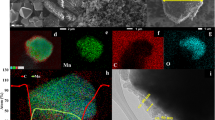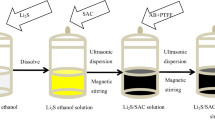Abstract
High voltage cathode materials LiNixMn2−xO4 (x = 0.4; 0.5) have been attracting greater attention in develo** high energy density Li-ion battery technology for electrical vehicles and large-scale applications. The main challenge of high voltage cathodes is severe electrolyte decomposition leading to short cell cycle life. In addition, LiNi0.4Mn1.6O4 cathode material processed with polyvinylidene fluoride (PVdF) binder generally suffers an oxidation decomposition as well as cathode delamination from current collectors during cycling. Herein, we suggest using sodium carboxymethyl cellulose (CMC), lithium polyacrylic acid (LiPAA) as water-soluble binders for replacing conventional PVdF in cathode processing to demonstrate the effectiveness on long-cycling of half-cell Li || LiNi0.4Mn1.6O4, full-cell SiO2-graphite || LiNi0.4Mn1.6O4 and SiO2 || LiNi0.4Mn1.6O4. In half-cell, the cells with water-soluble binders-based cathode exhibited a higher discharge capacity than the one using PVdF binder (CMC—126.0 mAh/g; LiPAA—125.7 mAh/g; PVdF—117 mAh/g at C/5, respectively). CMC and LiPAA also improve retention capacity up to 90% after 500 cycles at C/3. Interestingly, LiPAA based electrode exhibits an excellent rate-capability with discharge capacity of 80 mAh/g at 8C. The stability of electrodes was also investigated by electrode chemical impedance spectroscopy (EIS) and Scanning electron microscope (SEM). In full-cell, CMC and LiPAA based cells showed effectiveness in decreasing transition metal dissolution and preventing the cathode degradation during long-cycling through its excellent capacity retention in 200 cycles at C/3.
Graphical Abstract








Similar content being viewed by others
References
Reddy, M.V., Mauger, A., Julien, C.M., et al.: Brief history of early lithium-battery development. Materials 13, 1884 (2020). https://doi.org/10.3390/ma13081884
Li, Y., Li, X., Wang, Z., et al.: An Ostwald ripening route towards Ni-rich layered cathode material with cobalt-rich surface for lithium ion battery. Sci. China Mater. 61, 719–727 (2018). https://doi.org/10.1007/s40843-017-9162-3
Noh, H.-J., Youn, S., Yoon, C.S., Sun, Y.-K.: Comparison of the structural and electrochemical properties of layered Li[NixCoyMnz]O2 (x = 1/3, 0.5, 0.6, 0.7, 0.8 and 0.85) cathode material for lithium-ion batteries. J. Power Sources 233, 121–130 (2013). https://doi.org/10.1016/j.jpowsour.2013.01.063
Taskovic, T., Thompson, L.M., Eldesoky, A., et al.: Optimizing electrolyte additive loadings in NMC532/graphite cells: vinylene carbonate and ethylene sulfate. J. Electrochem. Soc. 168, 010514 (2021). https://doi.org/10.1149/1945-7111/abd833
Wu, X., **a, S., Huang, Y., et al.: High-performance, low-cost, and dense-structure electrodes with high mass loading for lithium-ion batteries. Adv. Funct. Mater. 29, 1903961 (2019). https://doi.org/10.1002/adfm.201903961
Börner, M., Niehoff, P., Vortmann, B., et al.: Comparison of different synthesis methods for LiNi0.5Mn1.5O4-influence on battery cycling performance, degradation, and aging. Energy Technol. 4, 1631–1640 (2016). https://doi.org/10.1002/ente.201600383
Dong, T., Zhang, H., Ma, Y., et al.: A well-designed water-soluble binder enlightening the 5 V-class LiNi0.5Mn1.5O4 cathodes. J. Mater. Chem. A 7, 24594–24601 (2019). https://doi.org/10.1039/C9TA08299A
Qian, J., Wiener, C.G., Zhu, Y., Vogt, B.D.: Swelling and plasticization of polymeric binders by Li-containing carbonate electrolytes using quartz crystal microbalance with dissipation. Polymer 143, 237–244 (2018). https://doi.org/10.1016/j.polymer.2018.04.021
Bigoni, F., De Giorgio, F., Soavi, F., Arbizzani, C.: Sodium alginate: a water-processable binder in high-voltage cathode formulations. J. Electrochem. Soc. 164, A6171–A6177 (2017). https://doi.org/10.1149/2.0281701jes
Lestriez, B.: Functions of polymers in composite electrodes of lithium ion batteries. C. R. Chim. 13, 1341–1350 (2010). https://doi.org/10.1016/j.crci.2010.01.018
Hitomi, S., Kubota, K., Horiba, T., et al.: Application of acrylic-rubber-based latex binder to high-voltage spinel electrodes of lithium-ion batteries. ChemElectroChem 6, 5070–5079 (2019). https://doi.org/10.1002/celc.201901227
Isozumi, H., Kubota, K., Tatara, R., et al.: Impact of newly developed styrene–butadiene–rubber binder on the electrode performance of high-voltage LiNi0.5Mn1.5O4 electrode. ACS Appl. Energy Mater. 3, 7978–7987 (2020). https://doi.org/10.1021/acsaem.0c01334
Zhong, H., He, J., Zhang, L.: Better cycle stability and rate capability of high-voltage LiNi0.5Mn1.5O4 cathode using water soluble binder. Mater. Res. Bull. 93, 194–200 (2017). https://doi.org/10.1016/j.materresbull.2017.04.036
De Giorgio, F., Laszczynski, N., von Zamory, J., et al.: Graphite//LiNi0.5Mn1.5O4 cells based on environmentally friendly made-in-water electrodes. Chemsuschem 10, 379–386 (2017). https://doi.org/10.1002/cssc.201601249
Pieczonka, N.P.W., Borgel, V., Ziv, B., et al.: Lithium polyacrylate (LiPAA) as an advanced binder and a passivating agent for high-voltage Li-ion batteries. Adv. Energy Mater. 5, 1501008 (2015). https://doi.org/10.1002/aenm.201501008
Al Ja’farawy, M.S., Hikmah, D.N., Riyadi, U., et al.: A review: the development of SiO2/C anode materials for lithium-ion batteries. J. Electron. Mater. 50, 6667–6687 (2021). https://doi.org/10.1007/s11664-021-09187-x
Chen, Z., **ang, T., **ong, Q., et al.: Highly active SiO2@C nanofiber: high rate and long cycling for lithium ion batteries. Ionics 27, 1385–1392 (2021). https://doi.org/10.1007/s11581-021-03935-z
Li, Y., Liu, L., Liu, X., et al.: Core–shell structured C/SiO2 composites derived from Si-rich biomass as anode materials for lithium-ion batteries. Ionics 28, 151–160 (2022). https://doi.org/10.1007/s11581-021-04335-z
Osman, N.S., Sapawe, N.: Optimization of silica (SiO2) synthesis from acid leached oil palm frond ash (OPFA) through sol–gel method. Mater. Today Proc. 31, 232–236 (2020). https://doi.org/10.1016/j.matpr.2020.05.300
Rafiee, E., Shahebrahimi, S., Feyzi, M., Shaterzadeh, M.: Optimization of synthesis and characterization of nanosilica produced from rice husk (a common waste material). Int. Nano Lett. 2, 29 (2012). https://doi.org/10.1186/2228-5326-2-29
Farhan, R.Z., Ebrahim, S.E.: Preparing nanosilica particles from rice husk using precipitation method. Baghdad Sci. J. 18, 0494 (2021). https://doi.org/10.21123/bsj.2021.18.3.0494
Li, S., Lan, L., Lu, L., et al.: Cerium doped LiNi0.5Mn1.5O4 composite with improved high temperature performance as a cathode material for Li-ion batteries. AIP Adv. 9, 25210 (2019). https://doi.org/10.1063/1.5082585
Yi, T.-F., Mei, J., Zhu, Y.-R.: Key strategies for enhancing the cycling stability and rate capacity of LiNi0.5Mn1.5O4 as high-voltage cathode materials for high power lithium-ion batteries. J. Power Sources 316, 85–105 (2016). https://doi.org/10.1016/j.jpowsour.2016.03.070
Favors, Z., Wang, W., Bay, H.H., et al.: Stable cycling of SiO2 nanotubes as high-performance anodes for lithium-ion batteries. Sci. Rep. 4, 4605 (2015). https://doi.org/10.1038/srep04605
Baranchugov, V., Markevich, E., Pollak, E., et al.: Amorphous silicon thin films as a high capacity anodes for Li-ion batteries in ionic liquid electrolytes. Electrochem. Commun. 9, 796–800 (2007). https://doi.org/10.1016/j.elecom.2006.11.014
Dawei, L., **aoxiao, Z., Yu, W., et al.: Adjusting ash content of char to enhance lithium storage performance of rice husk-based SiO2/C. J. Alloys Compd. 854, 156986 (2021). https://doi.org/10.1016/j.jallcom.2020.156986
Guo, Y., Chen, X., Liu, W., et al.: Preparation of rice husk-based C/SiO2 composites and their performance as anode materials in lithium ion batteries. J. Electron. Mater. 49, 1081–1089 (2020). https://doi.org/10.1007/s11664-019-07785-4
Sivonxay, E., Aykol, M., Persson, K.A.: The lithiation process and Li diffusion in amorphous SiO2 and Si from first-principles. Electrochim. Acta 331, 135344 (2020). https://doi.org/10.1016/j.electacta.2019.135344
Zou, F., Manthiram, A.: A review of the design of advanced binders for high-performance batteries. Adv. Energy Mater. 10, 2002508 (2020). https://doi.org/10.1002/aenm.202002508
Wang, Z., Dupré, N., Gaillot, A.-C., et al.: CMC as a binder in LiNi0.4Mn1.6O4 5 V cathodes and their electrochemical performance for Li-ion batteries. Electrochim. Acta 62, 77–83 (2012). https://doi.org/10.1016/j.electacta.2011.11.094
Wang, F., Lin, Z., Liu, L., et al.: Does polarization increase lead to capacity fade? J. Electrochem. Soc. 167, 090549 (2020). https://doi.org/10.1149/1945-7111/ab956b
Ogihara, N., Itou, Y., Sasaki, T., Takeuchi, Y.: Impedance spectroscopy characterization of porous electrodes under different electrode thickness using a symmetric cell for high-performance lithium-ion batteries. J. Phys. Chem. C 119, 4612–4619 (2015). https://doi.org/10.1021/jp512564f
Gaberšček, M.: Understanding Li-based battery materials via electrochemical impedance spectroscopy. Nat. Commun. 12, 6513 (2021). https://doi.org/10.1038/s41467-021-26894-5
Kasireddy, S.R., Gangaja, B., Nair, S.V., Santhanagopalan, D.: Mn4+ rich surface enabled elevated temperature and full-cell cycling performance of LiMn2O4 cathode material. Electrochim. Acta 250, 359–367 (2017). https://doi.org/10.1016/j.electacta.2017.08.054
Zhan, C., Wu, T., Lu, J., Amine, K.: Dissolution, migration, and deposition of transition metal ions in Li-ion batteries exemplified by Mn-based cathodes—a critical review. Energy Environ. Sci. 11, 243–257 (2018). https://doi.org/10.1039/C7EE03122J
Pieczonka, N.P.W., Kim, J.-H., Halalay, I.C., et al.: The effect of crystal structure, chemical composition, and binder on the full-cell performance of high voltage spinel positive electrodes for lithium-ion batteries. ECS Meeting Abstracts MA2013-02:1177–1177. https://doi.org/10.1149/MA2013-02/14/1177 (2013)
Acknowledgements
This work was supported by the Department of Science and Technology in Ho Chi Minh City (DOST) under contract No. 54/2020/HĐ-QPTKHCN.
Author information
Authors and Affiliations
Corresponding author
Ethics declarations
Competing Interest
The authors declare that they have no conflict of interest.
Additional information
Publisher's Note
Springer Nature remains neutral with regard to jurisdictional claims in published maps and institutional affiliations.
Rights and permissions
Springer Nature or its licensor (e.g. a society or other partner) holds exclusive rights to this article under a publishing agreement with the author(s) or other rightsholder(s); author self-archiving of the accepted manuscript version of this article is solely governed by the terms of such publishing agreement and applicable law.
About this article
Cite this article
Nguyen, N.T.B., Nguyen, H.V., Tran, N.T. et al. Eco-friendly Aqueous Binder-Based LiNi0.4Mn1.6O4 Cathode Enabling Stable Cycling Performance of High Voltage Lithium-Ion Batteries with Biomass-Derived Silica. Electron. Mater. Lett. 19, 239–250 (2023). https://doi.org/10.1007/s13391-022-00393-1
Received:
Accepted:
Published:
Issue Date:
DOI: https://doi.org/10.1007/s13391-022-00393-1




